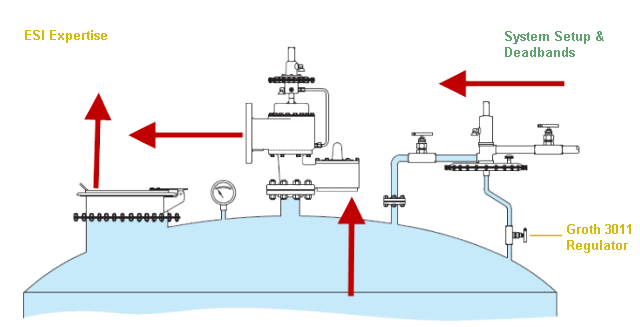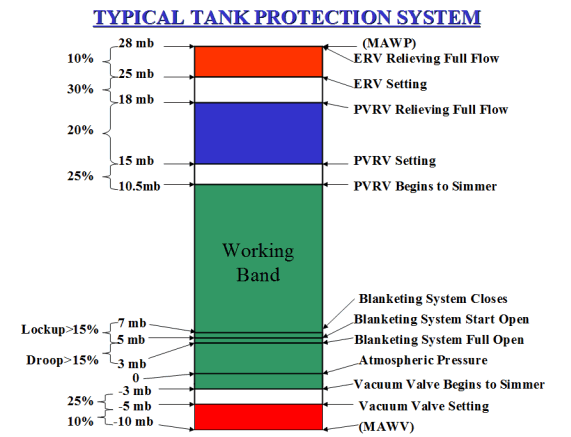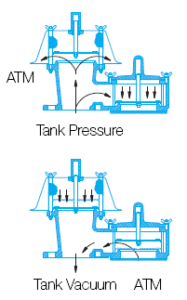MENUMENU

It is impossible for a regulator to sense 10 mbarg in the tank while taking Nitrogen at say 6 Barg into the tank through the same nozzle. ESI have come across different valves on tank farms without sense lines and the simple truth is that they do not shut off until the tank has reached approximately double the set point.
At that stage, the conservation vent has already started to open which means Nitrogen is being wasted. If there is an interaction such as this it will not be long before the emergency vent opens and then if the vents are lifting and slamming shut constantly it will only be a few weeks until the seals are damaged which means that the tank will not be able to hold a Nitrogen blanket and Nitrogen usage goes way up and all the conservation vents and emergency vents need new seals.

Groth Corporation’s Pressure/Vacuum Relief Valves, Pressure Relief Valves, Vacuum Relief Valves, Pilot Operated Valves, Flame and Detonation Arresters, Emergency Relief Valves, Waste Gas Burners, Pressure Regulators and more have been protecting refineries, chemical processing plants and facilities with atmospheric, fixed-roof storage tanks for more than 50 years.
Pressure/Vacuum Relief Valves, Pressure Relief Valves, Vacuum Relief Valves and other pressure relief devices are important emission control devices. Relief valves protect against damage from pressure or vacuum and reduce losses from product evaporation. They are an important step in protecting the environment from harmful VOCs (Volatile Organic Compounds).
Flame and detonation arresters reduce the risk of damage or injury from fire. Groth Corporation is committed to providing innovative solutions, quality products and comprehensive service to improve the safety of your plant. Our products provide cost savings by reducing media loss and help to protect the environment for the next generation.
The pressure/vacuum valve is a protection device mounted on a nozzle opening on the top of a fixed roof atmospheric storage tank. Its primary purpose is to protect the tank against rupturing or imploding. Without an opening or a controlled opening, a fixed roof atmospheric tank would rupture under increasing pressure caused by pumping liquid into the tank or as a result of vapour pressure changes caused by severe thermal changes. Imploding, or the collapsing of a tank, occurs during the pumping out procedure or thermal changes.
As the liquid level lowers, the vapour space pressure is reduced to below atmospheric pressure. This vacuum condition must be alleviated through a controlled opening on the tank. In short, the tank needs to breathe in order to eliminate the possibility of rupturing or imploding. Because of its primary function, a pressure/vacuum valve is commonly referred to as a “breather valve”.
Flame arresters are fire safety devices. They prevent flames from entering a tank and also provide protection from flashes within a tank. They can also be used as an in-line flashback prevention device.
The primary function of the emergency relief valve is to provide a controlled opening on a tank that will be large enough to prevent rupturing of the tank under severe pressure increases caused by close proximity to intense fire. Each of these safety devices is used on the atmospheric, fixed roof, non-refrigerated, storage tank.
API Standards are provided as an engineering aid for the specification and selection of “normal” and “emergency” pressure and vacuum relief valves for above-ground liquid petroleum storage tanks. Normal venting capacity is obtained without exceeding pressure or vacuum that would cause physical damage or permanent deformation to the tank. The following will help in sizing a pressure/vacuum valve:
How does a pressure/vacuum valve operate? Most atmospheric tanks require a venting device that will allow large volumes of vapour to escape under relatively low pressures.
Usually, the allowable set pressure is in inches of water column pressure, both for positive and vacuum conditions.
This is because most large storage tanks have a relatively low maximum allowable working pressure.
These tanks are generally large-volume welded vessels that are built to API 650 standard. In order to accommodate large volumes at low set pressures, these valves have ports that are greater in area than the inlet or nozzle connection.
The low setting required necessitates weight loading the valve as opposed to spring loading.
Because of the above, a pressure/ vacuum valve requires approximately 100% over-set pressure in order to reach the full opening of the valve.
Call us in Ireland at +353 21 4510900 or UK at+44 1633 877505 or message us via our online form or web chat.